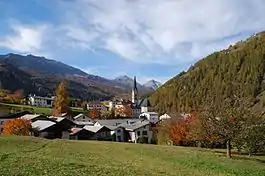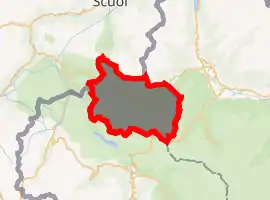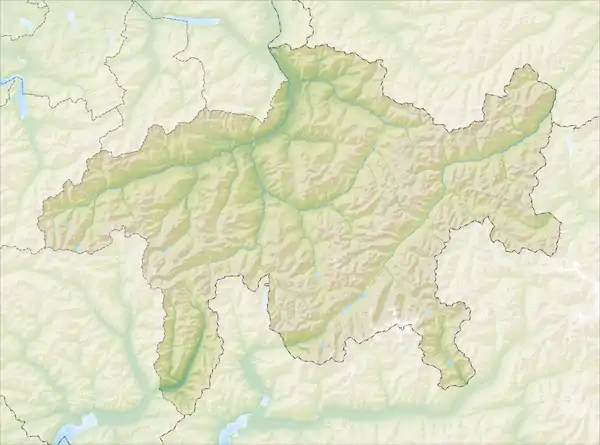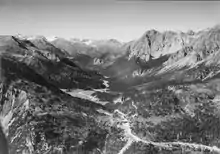Val Müstair
Val Müstair is a municipality in the Engiadina Bassa/Val Müstair Region in the Swiss canton of Graubünden. It was formed on 1 January 2009 through the merger of Tschierv, Fuldera, Lü, Valchava, Santa Maria Val Müstair and Müstair.
Val Müstair | |
|---|---|
 | |
_wappen.svg.png.webp) Coat of arms | |
Location of Val Müstair 
| |
 Val Müstair  Val Müstair | |
| Coordinates: 46°36′N 10°25′E | |
| Country | Switzerland |
| Canton | Graubünden |
| District | Engiadina Bassa/Val Müstair |
| Area | |
| • Total | 198.65 km2 (76.70 sq mi) |
| Population (2018-12-31)[2] | |
| • Total | 1,460 |
| • Density | 7.3/km2 (19/sq mi) |
| Time zone | UTC+01:00 (Central European Time) |
| • Summer (DST) | UTC+02:00 (Central European Summer Time) |
| Postal code(s) | 7537 |
| SFOS number | 3847 |
| Surrounded by | Tschierv, Fuldera, Lü, Valchava, Santa Maria Val Müstair and Müstair. |
| Website | www SFSO statistics |
Demographics
Val Müstair has a population (as of 31 December 2019) of 1,437.[3]
Geography

The Val Müstair (German: Münstertal, Italian: Val Monastero) is a mountain valley in the Swiss Alps. It connects the Fuorn Pass, (2,149 m (7,051 ft)) with the Italian province of South Tyrol and the Vinschgau (914 m (2,999 ft)).
The Benedictine Convent of Saint John at Müstair (monastery), a World Heritage site, was probably founded by Charlemagne, sharing history with its neighbor, the Marienberg Abbey.
The most important villages in the Val Müstair are: Tschierv (1,660 m (5,450 ft)), Valchava (1,412 m (4,633 ft)), Sta. Maria (1,375 m (4,511 ft)), Müstair (1,247 m (4,091 ft)) (all Swiss) and Taufers im Münstertal in South Tyrol. There are no other inhabited connected valleys, but the road over the Umbrail Pass (and the Stelvio Pass) is connected with Sta. Maria.
The largest part of the valley is part of the Swiss canton of Graubünden. A small part lies within the Italian province of South Tyrol. The border is located at approximately 1245 meter between Müstair (1247 meter) and Taufers im Münstertal (1240 meter).
The river in the valley is the Rom (Il Rom or Rombach).
Naming convention
Contrary to the common notion, where the beginning of a valley is referred as the "upper valley" and the end as the "lower valley", in Val Müstair these are referred to as "inner" and "outer" respectively. This is often reflected in location names.
For instance, the valley is traditionally divided into three thirds:
- Terzal d'Aint (inner third) with Tschierv, Fuldera and Lü
- Terzal d'Immez (middle third) with Valchava and Sta. Maria
- Terzal d'Oura (outer third) with Müstair
Incidentally, this division corresponds to the first three plateaus occurring on the Swiss part of the valley.
Language
The majority of the population in the new municipality speaks Romansh, with a large German speaking minority. The following table lists the historical language distribution of the formerly independent municipalities and also for the combined municipality:
| Languages in Val Müstair | |||||||
| Languages | Villages | Census 1980 | Census 1990 | Census 2000 | |||
| Number | Percent | Number | Percent | Number | Percent | ||
| German | |||||||
| Fuldera | 5 | 5.00% | 17 | 16.19% | 27 | 23.48% | |
| Lü | 4 | 7.14% | 5 | 9.09% | 11 | 17.74% | |
| Müstair | 123 | 17.40% | 160 | 21.28% | 184 | 24.70% | |
| Sta. Maria | 78 | 20.31% | 106 | 28.73% | 83 | 25.38% | |
| Tschierv | 6 | 4.48% | 18 | 12.24% | 29 | 18.83% | |
| Valchava | 44 | 20.18% | 31 | 15.20% | 37 | 18.32% | |
| Total | 260 | 16.26% | 337 | 20.65% | 371 | 23.12% | |
| Romansh | |||||||
| Fuldera | 95 | 95.00% | 87 | 82.86% | 86 | 74.78% | |
| Lü | 51 | 91.07% | 50 | 90.91% | 51 | 82.26% | |
| Müstair | 574 | 81.19% | 578 | 76.86% | 543 | 72.89% | |
| Sta. Maria | 295 | 76.82% | 259 | 70.19% | 228 | 69.72% | |
| Tschierv | 128 | 95.52% | 125 | 85.03% | 119 | 80.27% | |
| Valchava | 168 | 77.06% | 167 | 81.86% | 163 | 80.69% | |
| Total | 1,311 | 81.99% | 1,266 | 77.57% | 1,190 | 74.14% | |
| Population | 1,599 | 100% | 1,632 | 100% | 1,605 | 100% | |
Heritage sites of national significance
The Benedictine Convent of Saint John is both listed as a Swiss heritage site of national significance and a UNESCO World Heritage Site.[4]
Weather
Müstair village has an average of 86.7 days of rain per year and on average receives 690 mm (27 in) of precipitation. The wettest month is August during which time Müstair receives an average of 86 mm (3.4 in) of precipitation. During this month there is precipitation for an average of 9.3 days. The month with the most days of precipitation is May, with an average of 10, but with only 80 mm (3.1 in) of precipitation. The driest month of the year is February with an average of 33 mm (1.3 in) of precipitation over 9.3 days.[5]
The higher elevation village of Sta. Maria Val Müstair has an average of 94.6 days of rain per year and on average receives 801 mm (31.5 in) of precipitation. The wettest month is August during which time Sta. Maria Val Müstair receives an average of 105 mm (4.1 in) of precipitation. During this month there is precipitation for an average of 10.6 days. The driest month of the year is February with an average of 34 mm (1.3 in) of precipitation over 10.6 days.[5]
Tourism
There is a small amount of car parking in the village. It is the starting point for a number of hiking trails. Above Tschierv, at the mountain Minschuns, is a little ski resort. In 2009, during the International Year of Astronomy, a new public observatory Alpine Astrovillage Lü-Stailas was inaugurated. The center is equipped with robotic telescopes for direct observations, as well as for astrophotography. The equipment is also used to provide introductory courses for amateur astronomers. The Astrovillage is located on a terrace at an elevation of 2,000 m (6,400 ft).[6]
Sports
Val Müstair has hosted several stages of the Tour de Ski, a cross-country skiing stage event.
Notable residents
Donna Leon, Usonian crime novelist.
Notes and references
- "Arealstatistik Standard - Gemeinden nach 4 Hauptbereichen". Federal Statistical Office. Retrieved 13 January 2019.
- "Ständige Wohnbevölkerung nach Staatsangehörigkeitskategorie Geschlecht und Gemeinde; Provisorische Jahresergebnisse; 2018". Federal Statistical Office. 9 April 2019. Retrieved 11 April 2019.
- "Ständige und nichtständige Wohnbevölkerung nach institutionellen Gliederungen, Geburtsort und Staatsangehörigkeit". bfs.admin.ch (in German). Swiss Federal Statistical Office - STAT-TAB. 31 December 2019. Retrieved 6 October 2020.
- Swiss inventory of cultural property of national and regional significance Archived 1 May 2009 at the Wayback Machine 21.11.2008 version, (in German) accessed 13-Oct-2009
- "Temperature and Precipitation Average Values-Table, 1961-1990" (in German, French, and Italian). Federal Office of Meteorology and Climatology - MeteoSwiss. Archived from the original on 27 June 2009. Retrieved 8 May 2009., the Müstair village weather station elevation is 1248 meters above sea level.
- "Alpine Astrovillage". Retrieved 16 May 2016.
See also
External links
| Wikimedia Commons has media related to Val Müstair. |
- Cumün da Val Müstair Official website (in Romansh and German)
- Turissem Val Müstair Tourism office (in German)
- Convent of St. John
- Online map
- Alpine Astro Village
- Grimm, PE: Val Müstair in Romansh, German, French and Italian in the online Historical Dictionary of Switzerland, 2007-12-20.
- Fuldera in German, French and Italian in the online Historical Dictionary of Switzerland.
- Lü in German, French and Italian in the online Historical Dictionary of Switzerland.
- Müstair (municipality) in German, French and Italian in the online Historical Dictionary of Switzerland.
- Sta. Maria Val Müstair in German, French and Italian in the online Historical Dictionary of Switzerland.
- Tschierv in German, French and Italian in the online Historical Dictionary of Switzerland.
- Valchava in Romansh, German, French and Italian in the online Historical Dictionary of Switzerland.